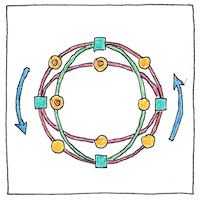Carl Adam Petri
computer science

|
Petri net
At the age of thirteen, Carl Adam Petri invented a graphic tool for modeling chemical processes. Circular symbols represent states, rectangular symbols represent transitions, directed arcs connect them, and tokens represent objects that exist in states. Transitions may “fire” concurrently when their input states have sufficient tokens. When a transition fires, it consumes tokens in input states and creates tokens in output states.
Automata
A bounded Petri net can be modeled as a finite-state machine in which nodes of the machine represent the reachable states of the net. Both are kinds of automata, that is, models or simulations of a process. Conditions, materials, and actions have their own behaviors like living things.
The same
For many things the thing itself and its simulation are the same.



Twenty-three years after he invented them, Petri described them in his doctoral thesis, Communication with Automata. Like many modeling languages, Petri nets have been extended for a many purposes.
See also in The book of science:
Readings in wikipedia:
Other readings: